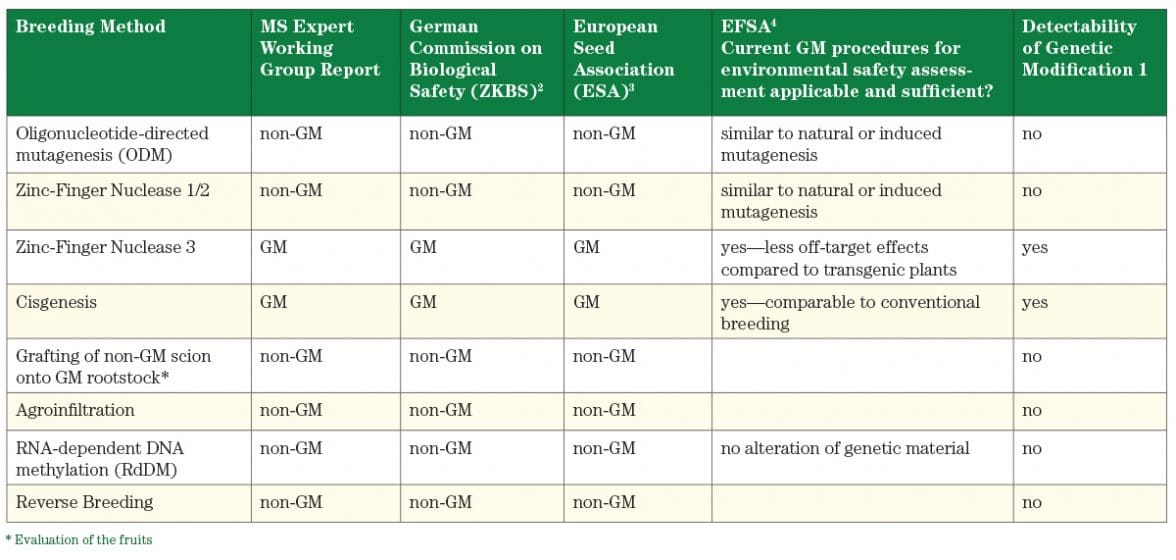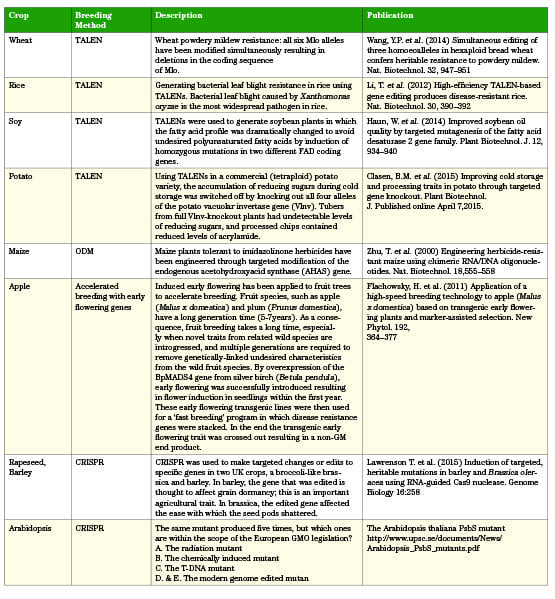A closer look at the politics surrounding the newer plant breeding techniques.
Plant breeders have always strived to create new variations of plant characteristics to provide solutions for disease and pest resistance, to achieve higher yields, to increase tolerance to environmental stress, and to breed new plant varieties that meet consumer expectations.
Plant domestication started some 10,000 years ago by farmers selecting the best performing plants in a field. It was not until 12,000 years later that the rediscovery of Mendel’s laws of heredity, in the early 1900s, turned the first plant breeding efforts from an art into science, and specialised farmer-breeders emerged, building a business concept on their efforts.
From that point in time, scientific breakthroughs in agricultural and biological sciences have accelerated. With an increased understanding of plant biology and plant genes, plant breeders have constantly improved their breeding tools to include a wide variety of breeding methods.
The development of newer plant breeding methods did not lead to a complete replacement of the older ones. Depending on the problems plant breeders have to solve, they must be able to choose the tools that enable them to reach their breeding goals in the most efficient and specific way. Conventional plant breeding methods, transgenesis or newer plant breeding methods are all essential components of the plant breeders’ toolbox.
Building on the mechanisms created by nature, the latest innovations in plant breeding methods simply achieve the relevant breeding results in less time and with greater precision.
A key issue, not only for plant breeders worldwide but also for society as a whole, is the evolving government public policies that govern plant varieties developed through the latest plant breeding methods. To ensure the use of these breeding methods is not stalled at the research and development stage, clear public policy is essential.
EU Regulatory Framework
In the EU, the harmonised regulatory framework dealing with organisms produced by modern bio-techniques (GMOs) dates back to 1990. Although GMO legislation has been revised during recent years, and additional legislation came into force in 2003 to regulate food and feed derived from GMO crops, the GM definition has not changed. 1
According to the Directive 2001/18, a ‘genetically modified organism (GMO) means an organism, with the exception of human beings, in which the genetic material has been altered in a way that does not occur naturally by mating and/or natural recombination’.
This definition takes the process with which an organism has been created, as well as the product (the genetic modification), into account. During the last 25 years, newer plant breeding methods have been developed. They create new challenges for regulators when applying the GMO definition from 1990.
Crops produced by some of the newer breeding methods cannot be distinguished from their conventionally bred counterparts. Enforcement issues will likely be raised because seeds and commodities derived from most of the newer breeding methods are indistinguishable from those derived from traditional breeding, and plants resulting from newer breeding methods cannot be identified as such. Regulatory costs for plant varieties falling under the current GM law are much higher than those needed for the approval and registration of non-GM plants.
In 2007, the EU commission asked a group of experts from Member States’ competent authorities (MS Expert Working Group) to evaluate a list of eight newer plant breeding methods in the context of the current EU GMO legislation (Directive 2001/18). The outcome of the evaluation has never been published officially by the EU Commission. However, the majority of the experts came to the conclusion that six of these newer breeding methods do not result in a GM plant. Other expert groups and plant breeders’ associations came to similar results (see Table 1)

(Directive 2001/18) on newer plant breeding methods.
Although these experts are aligned with regard to the outcomes of their evaluations, the EU Commission has still not come to a conclusion. The publication of guidelines by the Commission has been delayed several times.
Non-governmental organisations, some organic farming organisations, and a German environmental authority published legal expert reports which had come to the conclusion that all newer breeding methods have to be regulated under current GM law because the GM definition of the EU legislation is according to their interpretation, a pure process-based definition, excluding the characteristics of the product created by those processes.
These entities blame industry for trying to introduce ‘GM through the backdoor’. Their legal expert statements were questioned by other official statements such as the ‘Opinion on the Legal Classification of New Plant Breeding Techniques, in particular ODM and CRISPR-Cas9’, which was published by the German competent authority in December 2015.5 This statement came to the conclusion “… that plants which exhibit point mutations induced by means of ODM and CRISPR-Cas9 techniques do not constitute GMOs within the meaning of the Directive. It is not only the use of a genetic engineering method that is decisive for classification as GMO but also the resulting product. This must differ from plants which could also arise through conventional breeding methods. For the point mutations in question here, this is not the case. Those genetic modifications could also arise through other mutagenesis techniques.”
A well-known expert from the organic sector raised his voice on the potential of newer plant breeding methods saying: “CRISPR/CAS has great potential! and “You can turn off genes for susceptibility to disease or insert from the related wild plant resistance genes back into modern varieties.”6
Similar Needs: Scientific Community and Seed Sector
The scientific community in Europe is alarmed by the ongoing debate and legal uncertainty which impede scientific progress. According to a statement issued by the European Plant Science Organisation, it “… welcomes the outcome of the majority opinion of the Member States expert working group report and asks the European Commission as a matter of urgency …. to provide legal certainty for science and industry concerning the application and exploration of New Plant Breeding Techniques.” 7
In addition, the scientific community asks for a more detailed and comprehensive discussion on a new approach for the regulation of new plants that might be exclusively based on the new characteristics of a product/trait. They also address the requirement that such a concept needs a clear and reliable definition, based on scientific evidence, of what constitutes a novel plant trait, and, thus, needs to be assessed by an appropriate body (legal certainty) to avoid overregulation, whereby an unwarranted number of processes and products will have to undergo expensive and lengthy authorisation procedures, creating a disadvantage for small- and medium-sized enterprises and scientists.

Legal Certainty is Essential
Governmental policy must be firmly based on sound scientific principles to avoid the risk of impeding innovation in plant breeding, otherwise farmers’ access to better varieties—and, consequently, the availability of improved and sufficient products for consumers—is in danger.
Regulatory policy will determine utilisation of methods across companies and across crops. An overly high regulatory burden will limit utilisation to the largest companies and cash crops (e.g. corn, soybeans) as well as to a limited number of traits (e.g. herbicide tolerance).
While products from newer breeding methods are in the R&D pipeline of several, if not the majority of, public institutes and companies, only one company has asked for regulatory assessment in some EU Member States. In 2015, the US-based company Cibus developed a herbicide-tolerant rapeseed variety using ODM, a breeding method which results in a non-GM product, according to the expert reports listed in Table 1.
Regulatory bodies in Germany, Sweden, the United Kingdom and Finland took the position that the Cibus rapeseed is non-GM, and could be released without approval. The EU Commission intervened, asking Member States to forbid the growing of rapeseed plants until the Commission came to a conclusion regarding the legal interpretation of Directive 2001/18.
In addition, several NGOs objected to the decision of the competent authority in Germany, but the Federal Office of Consumer Protection and Food Safety rejected the objection against its decision. All these activities have triggered a public debate about the future regulation of new plant breeding techniques.
Harmonised Government Policies
Maintaining and increasing agricultural production is a global concern, so there is clearly a need for harmonised government policies. Harmonisation facilitates the trade and movement of seed, and helps create a level playing field. Consistent, science-based policy means farmers and consumers around the world can enjoy the benefits of products developed through the latest breeding methods.8
So far, there are only a few precedents of governmental decisions regarding whether a crop obtained by a newer breeding method is under regulation usually applied specifically for GMOs.9 Argentina is the first country that has adopted its GM regulatory framework to be applicable to newer breeding techniques. In the United States, there are ongoing discussions for a revised regulatory framework10, although the first products from newer breeding methods have already been cleared by the United States Department of Agriculture as being non-GM.11
In Canada, the whole regulatory system is established on a product-based approach, whereby the process of creating a new plant is more or less irrelevant to its regulatory status. These few examples show the diversity of regulatory approaches worldwide. However, inconsistent policies make research collaborations difficult, and have a negative impact on commercial seed and commodity trade in agricultural products.
From a competitive point of view, inconsistent policies will have differential negative impact on plant breeding innovation across countries because access to genetic diversity, which is a prerequisite for successful breeding, will be restricted by regulation. In the end, the range of new varieties for farmers and new products for consumers will be determined by different regulatory burdens.
Support Innovation in Plant Breeding: Policy-Makers
Keeping in mind the global challenges associated with feeding 11 billion people in 2050, and the severe negative impact of climate change on agriculture, innovation in plant breeding is one of the key factors to overcoming these adversities.
A responsible policy should, therefore, intend to make the tools for creating innovation in agriculture available. This can be accomplished by not regulating plants that are similar or indistinguishable from varieties produced through established breeding methods, or have been created by nature. Innovation needs legal certainty, and regulation should be grounded in sound scientific principles. Inappropriate regulation and associated costs will impede the utilisation of innovative breeding methods.
Government policies should facilitate innovation and utilisation of advanced breeding applications by public and private plant breeders in developed and developing countries, and harmonised policies are essential for both research collaboration and trade.
Editor’s Note: Petra Jorasch is vice-secretary general of the German Plant Breeders’ Association BDP.
1 Lusser et al., 2011. New Plant Breeding Techniques—State-of-the-Art and Prospects for Commercial Development, JRC Scientific and Technical Reports.
2 Stellungnahme der ZKBS zu neuen Techniken für die Pflanzenzüchtung, June 2012 (http://www.bvl.bund.de/SharedDocs/Downloads/06_Gentechnik/ZKBS/01_Allgemeine_Stellungnahmen_deutsch/04_Pflanzen/Neue_Techniken_Pflanzenzuechtung.pdf?__blob=publicationFile&v=3 )
3 ESA Position on New Breeding Techniques—Ensuring Progress and Diversity in Plant Breeding, 2012 https://www.euroseeds.eu/system/files/publications/files/esa_12.0446.2.pdf and https://www.euroseeds.eu/esa150543-regulatory-approaches-modern-plant-breeding-case-mutagenesis-and-new-gene-editing
4 Scientific Opinion Addressing the Safety Assessment of Plants Developed Using Zinc-Finger Nuclease 3 and Other Site-Directed Nucleases with Similar Function, EFSA Journal: 2012;10(10):2943 [31 pp.] and Scientific Opinion Addressing the Safety Assessment of Plants Developed through Cisgenesis and Intragenesis” EFSA Journal 2012;10(2):2561 [33 pp.] and EFSA Mandate M-2015-0183 from 15.10.2015.
5http://www.bvl.bund.de/SharedDocs/Downloads/06_Gentechnik/Opinion_on_the_legal_classification_of_New_Plant_Breeding_Techniques.pdf?__blob=publicationFile&v=2
6 http://www.ask-force.org/web/Organotransgenic/Maurin-Niglli-CRISPR-Great-Potential-TAZ-20160406.pdf
7 EPSO statement on “Crop Genetic Improvement Technologies” http://www.epsoweb.org/file/2038
8 http://www.worldseed.org/wp-content/uploads/2016/03/PBI_statement_2016.docx
9 Agustina I Whelan and Martin A Lema, Regulatory framework for Gene Editing and other New Breeding Techniques (NBTs) in Argentina in GM Crops & Food, 6:253–265, 2015
10 https://www.whitehouse.gov/blog/2015/07/02/improving-transparency-and-ensuring-continued-safety-biotechnology
11 Schiemann & Hartung. Safety assessment and regulation of new plant breeding technologies. In Proceedings of the Plant Biotech Denmark Annual Meeting (2013) http://plant-biotech.dk/annual_meeting/2013/schiemann.pdf













